URINE- SYNOVIAL FLUID CULTURE
POSITIVE URINE CULTURES
MAJOR CAUSE OF INAPPROPRIATE ANTIMICROBIAL USE IN VETERINARY PRACTICE
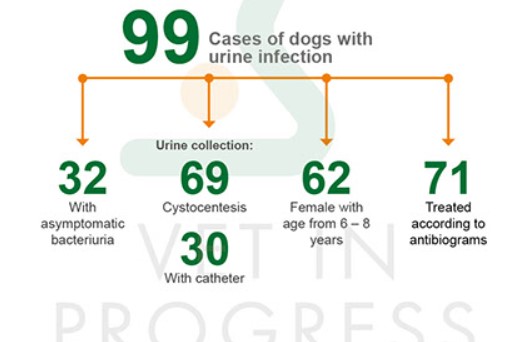
QUANTITATIVE URINE CULTURE
THE ROLE OF THE LABORATORY IN THE INVESTIGATION OF THE CLINICAL IMPORTANT BACTERIURIA
1. Accurate and punctual diagnosis of the infection and identification of the bacteria re sponsible for
the infection and antibiotic sensitivity tests
2. Appropriate collection and processing of samples
3. Interpretation of results according to the clinical signs for an effective treatment
METHOD OF URINE CULTURE
1. Appropriate collection and transfer of samples
2. Inoculation on nutrient agar
3. Incubation
4. Interpretation and evaluation of cultures according to the sampling method and the clinical signs
5. Identification and antibiogram
METHODS OF URINE SAMPLING FOR CULTURE
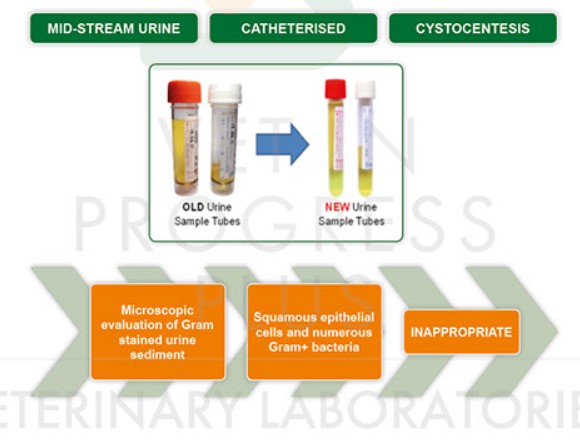
LABORATORY METHODS OF DIAGNOSIS OF URINARY TRACT INFECTION
1. Non culture method- Detection of pyuria and bacteriuria
i. Chemical methods – multiple reaction stripes
- leucocyte esterase
- induction of nitrate to nitrite
ii.Microscopic examination of urine
- fresh specimen
- Gram stain
2. Culture method
PERCENTAGE OF BACTERIA ISOLATED
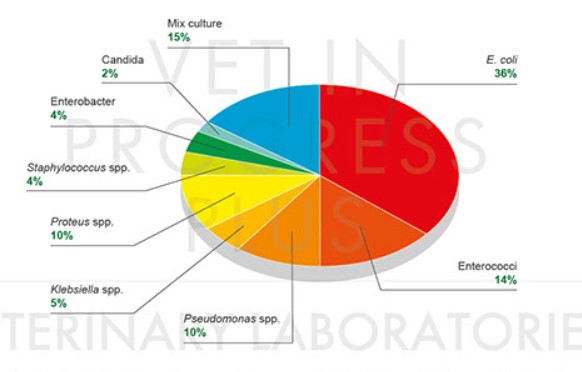
INTERPRETATION OF RESULTS FOR COMMON URINE PATHOGENS
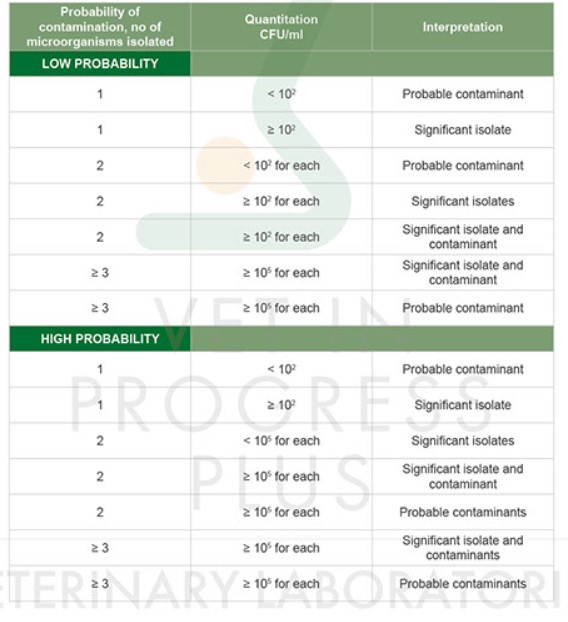
URINE CULTURE RESULTS INTERPRETATIONS
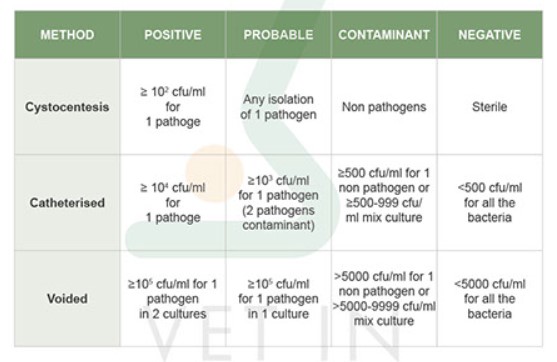
FALSE RESULTS
1. False negative urine culture
- Use of antibiotics
- Topical use of antiseptics
- Hyperhydration
- Laboratory mistake – method, evaluation
2.False positive urine culture
- Delay during culture
- Wrong prepare of the animal and during the sampling
- Overestimation of the result
BACTERIAL ARTHRITIS
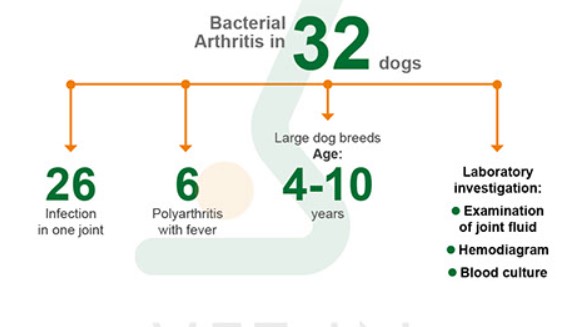
METHOD OF SAMPLING FOR JOINT FLUID
- Skin disinfection with iodine compounds or 70% alcohol
- General examination: collection of 2-2.5 ml of fluid in an EDTA tube and good shaking
- Culture(aerobic): 1 ml of fluid in a sterile tube
- Culture (anaerobic): 1 ml of fluid in a blood culture vial for anaerobes (BACTEC PLUS Anaerobic)
- Don’t collect sample with swabs – inappropriate sample
BLOOD CULTURE
- Disinfect the cap of the vial with 70% isopropyl or ethyl alcohol and the site of veni puncture with the above disinfectants from the center to the circumference for 2 min
- Blood collection with a syringe and change needle for the inoculation of the vial
- BACTEC PLUS Aerobic vial for aerobic bacteria and BACTEC PLUS Anaerobic for anaerobic bacteria
- The blood is sampled during the rise of the fever and if possible before the antibiotic
- Persistent fever: at least 2 blood cultures within 12 hours and if possible before the use of antibiotics
PERCENTAGE OF ISOLATED ORGANISMS
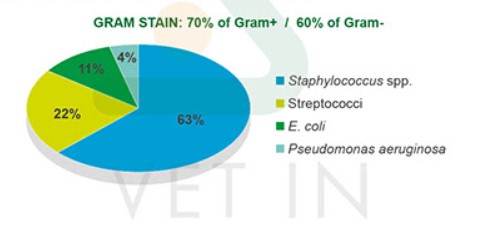
SENSITIVITY TEST OF THE BACTERIA
• Disk diffusion method in agar
• Broth and agar dilution methods
- Determine the minimum inhibitory concentration MIC-method E-test or automati cally analyzed
- Determine the minimum bactericidal concentration MBC
• Quality control of antibiogram with standard reference microorganisms
• KClinical category/Definition:
- Susceptible (S)
- Resistant (R)
- Intermediate (I)
CAUSES OF DISCREPANCY BETWEEN IN VITRO AND IN VIVO RESULTS
• Antibiotic failure to reach the infection site
• Reduced development of the microorganism in vivo due to increase of the time
• Population duplication time from 20 to e.g. 70*
• Antibiotics competition in the site of the infection
• Resistance development of during therapy
ANTIBIOTIC RESISTANCE
TRANSMISSION OF PLASMIDS THAT CONTAIN THER FACTORS WITH THE MECHANISMS OF TRANSFORMATION, TRANSDUCTION AND CONJUGATION

Ε.coli RESISTANT DEVELOPMENT
• Μέθοδος διάχυσης δίσκων αντιβιοτικών σε άγαρ σύμφωνα με τις οδηγίες CLSI
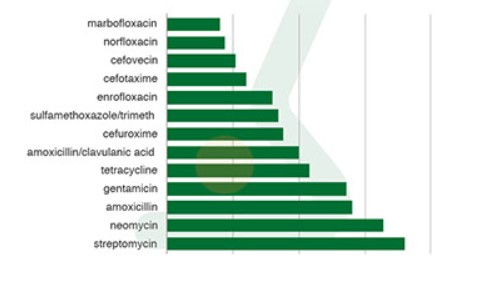
St.aureus RESISTANT DEVELOPMENT
• Μέθοδος διάχυσης δίσκων αντιβιοτικών σε άγαρ σύμφωνα με τις οδηγίες CLSI
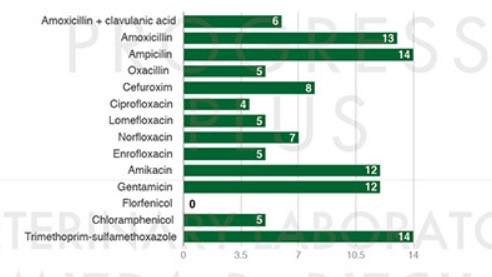
TIPS
• Antibiotic resistance spreads rapidly and to all directions
• Bacteria develop new types of enzymes to survive or new types of old enzymes with new inhibitory capacities
• Gradual resistance development demands orthological empiric therapy for the first days and rapid laboratory diagnosis
• Antimicrobial synergy: a dose of antibiotic is enough to select resistant micro organisms from the normal flora of the patient
- Laboratories:
- Vet in Progress Plus
- Service:
- Bacteriology - Mycology
- Category:
- Positive Urine Cultures

